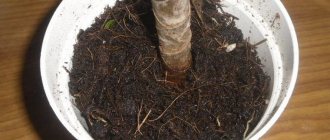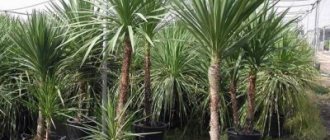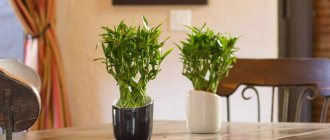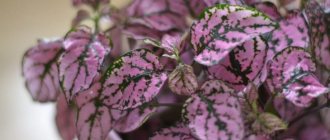Home Cottage and vegetable garden
Dracaena is a southern plant. It brings special beauty and comfort to the house. There are about 60 species of different dracaenas, which differ among themselves in growth height, color, size and width of leaves.
But there is a lot in common between them, namely:
- dense trunk wood;
- When the leaves fall off, the trunk is exposed.
When planning to grow a plant in the house, it is important to take care to create the most suitable conditions for those where it is accustomed to grow. The room must be provided with the required temperature, humidity, duration and intensity of lighting.
Where did dracaena come from, and what types can you grow at home?
The homeland of dracaena is the tropical forests of America, Africa and Asia, as well as the Canary Islands. It can be safely classified as a palm plant; it looks like a palm tree: under favorable conditions it can reach 20 meters in length, while the trunk is most often bare, and the foliage forms a crown in the upper part. The root system is smooth and even with a hint of rust. There are several decorative types of dracaena that are grown at home.
Dracaena fragrant (Frangrance, Malaika) - the flower received its name due to the pleasant aroma emanating from the inflorescence. When flowering, more than one flower is formed; the palm tree has a peduncle that grows in the center of the rosette; small flowers appear on it in large numbers, which are the source of the smell. At home, fragrant dracaena blooms very rarely, only in ideal conditions. A flowering plant can be found either in its homeland or in a botanical garden.
As a houseplant, fragrant dracaena is found both tall and dwarf. The leaves are succulent, dense, and have a refined curve. They can reach half a meter in length with a width of 10 cm. The leaves form a crown at the top of the trunk, which becomes bare due to the falling of leaves during plant growth. Often among the varieties of broad-leaved fragrant dracaena there are specimens with decorative leaf colors: Lindenii, Massangeana, Surprise.
Derema dracaena grows tall, even in a small pot. It differs from other species in the abundance of succulent foliage on the trunk. Some varieties have light green leaves 5 cm wide and about 50 cm long. Other varieties have variegated leaves on a green background. The foliage shape is elongated with a smooth surface. This palm tree will not please you with its flowering; all that remains is to enjoy its exotic appearance. The following varieties of Derham dracaena have been bred for home keeping: Janet Craig Compacta, Lemon Lime, Warneckii, White Stripe.
Among other species, the most common is dracaena marginata. In its homeland (the island of Madagascar) it can grow up to 6 meters in height. Due to the decorative appearance of its long, thin leaves, this variety is sometimes called dragonwood. The length of the leaf reaches 70 cm, the width is from 1 to 1.5 cm. Flower growers call it Marginata. At home, the plant is kept in containers. As it grows, the trunk becomes bare, and decoratively colored leaves form a crown. In its homeland, the plant not only blooms, but also bears fruit. At home, a racemose inflorescence can be seen extremely rarely. The varieties Colorama, Sandera, Bicolor, and Tricolor are popular among gardeners.
Dracaena dragon can grow up to 18 meters in height with a trunk diameter of 5 meters. At home its height does not exceed 1.5 meters. The foliage is oblong, elastic, pointed at the ends. Each shoot is crowned with a bunch of leaves 60 cm long and 3 cm wide. If the flower is well lit, the edging becomes pink. As they grow, the lower leaves turn yellow and fall off.
Dracaena Godsefa is impressive in its appearance, as it is not similar to other varieties of the plant. It grows as a bush with leaves about 10 cm long and shaped like an egg. It grows up to 70 cm in height. The leaves have varied shades: from greenish to beige. Has shoots in the form of wire. It begins to bloom almost immediately after planting with fragrant light green flowers. After flowering, fruits appear in the form of berries. Godsefa is not afraid of the temperature dropping.
Dracaenas have a positive effect on the human nervous system, give a good mood and bring peace of mind.
Creating tropics in an apartment - how much light does a palm tree need?
Dracaena is a tropical plant and needs warmth and moisture. The plant can grow in partial shade, but it is better to place it in a room in a well-lit place. At the same time, we protect it from direct sunlight and provide diffused lighting. The need for lighting depends on the variegation of the leaves. Varieties with variegated foliage need a lot of light; green leaves do not need a lot of light. If dracaena does not receive enough light, it grows and develops poorly.
If the palm tree is on the windowsill, then the windows should face the east or west side. If the windows face south, then we provide shading. Dracaena will not live long on a north window. These recommendations should be taken into account when choosing a location for the plant. The flower does not like heat either. In summer, a comfortable temperature for her will be from 20 to 25 degrees, in winter - from 15 to 18. If the air in the room is dry, place a container of water next to the pot, and spray the leaves more often with a spray bottle. We maintain indoor air humidity within 60-70%. We regularly ventilate the room, since dracaena needs fresh air, but it does not like drafts.
Temperature
Many people think that tropical plants love high temperatures, but this does not apply to dracaena. Ideal temperature is from +5 to +25 0C. In winter, it is worth maintaining the temperature no more than +15 0C, and the rest of the time you can provide +20 0C.
Many gardeners have found that temperatures of +11 0C are easier to tolerate than +30 0C. When ventilating the room, the plant should not be placed in a draft, as this will negatively affect it.
In summer, you can take the plant to the balcony or place it outside. But it’s also worth choosing a place there; they don’t place it in the wind.
Watering and fertilizing - complete nutrition
In order for the plant to have lush greenery and a healthy appearance, it must be properly watered. Features of watering depend on the specific variety, but there are general recommendations. The growth period for palm trees occurs in the spring-summer season, so at this time we water abundantly. Between waterings we take a break of about 8 days, the surface layer should dry out by 2-3 cm. We take soft water for irrigation; it is better to boil or filter tap water. It is important that the water contains as few impurities as possible; fluorine and its compounds are especially harmful. Before each watering, we loosen the soil.
In autumn, we reduce watering, as the soil dries more slowly. In winter, the plant rests, so it is enough to water it several times a month. The reference point is the soil. If the plant is located near a heating device, the soil dries faster and you have to water it more often. Frequent watering can have a detrimental effect on the root system of the dracaena, which can begin to rot, resulting in the death of the flower. Therefore, be careful when watering. We spray the leaves regularly, wipe the leaves once a month to remove dust and dirt. Sometimes it is useful for a plant to give it a warm shower.
We select complex fertilizers or mixtures for deciduous plants for dracaena, which are sold in specialized stores. It is better to buy fertilizers in liquid form. Add them to the water and water the flowers with this solution. We feed the plants during the period when they are actively growing - from early spring to autumn. We fertilize once every 2 weeks, in the winter season - no more than once a month.
To accelerate growth, dracaena needs phosphorus, nitrogen and potassium. When choosing fertilizers, pay attention that the named elements are present in the composition; they must be in a ratio of 1: 3: 3, as listed. The drug Zircon, which is intended for growing palm trees, is popular. We dilute it according to the instructions and add it to the water for irrigation.
Timing for planting dracaena at home
Regardless of the chosen propagation method (seeds or cuttings), the optimal time for planting a plant is considered to be spring, or more precisely, the period from March to mid-summer. At this time, all processes of plant growth and development are slightly accelerated, so planting material has a better chance of taking root. To speed up the process even more, it is useful to soak the seeds in a solution of Epin or Zircon.
Did you know? Dracaena juice is included in metal varnish, and it can also give human hair a lasting golden hue.
The same applies to transplanting plants from place to place. Young specimens 1-2 years old are usually transplanted into a new pot after 2 years, and adult plants - every five years of life. In autumn, you can change the soil only as a last resort: if the plant is sick, or if it is necessary to remove the dracaena from the shipping box. In such a situation, simply pay more attention to the plant and try to create the most suitable conditions for its continued existence.
Replanting and pruning - to make the plant comfortable
After purchasing the dracaena, we give it time to adapt - about 21 days, then transplant it into another pot. We carry out the transshipment carefully together with a lump of earth, in order to avoid damage to the root system. We fill the free space with pre-purchased soil or prepared soil ourselves. If you prepare the mixture yourself, take the following components:
- turf land;
- leaf soil;
- peat;
- humus;
- coarse sand.
Mix all components in equal proportions. For disinfection, add wood ash. We put drainage at the bottom of the pot. When choosing a flowerpot, we evaluate the size of the plant. If its height is 40 cm, then we take a container with a diameter of 16 cm.
We replant a young palm tree regularly once a year; an old plant does not need frequent replanting, so it is better to replant it once every 2-3 years. The best time for replanting is considered to be the time when the plant comes out of dormancy: late winter-early spring. We transplant the plants into containers 2-3 cm larger than the previous one. Add the required amount of soil, water and place in a warm place. When the soil settles, add more soil if necessary.
To give the palm a beautiful shape or to prevent the spread of the disease, we perform pruning, which is best done in winter, when the plant is dormant. For pruning we use garden shears. Before the procedure, we must disinfect the instrument. After cutting, sprinkle the cut area with wood ash or crushed coal. If you cut off the top of a palm tree, new shoots will begin to grow from the sides.
If we do pruning for branching, then we prune plants that have reached a height of 30 cm. We cut the shoots 6 cm below the last leaves or leave the height necessary to form the shape of the bush. After 17-25 days, buds appear under the cut, from which side shoots subsequently grow. After pruning, we provide the plant with good lighting, watering and spraying so that new branches grow better.
3 propagation methods - choose any
Dracaena has another name - the tree of happiness. The American Indians have a legend about how a young warrior fell in love with the chief’s daughter and was able to marry her after he stuck a stick in the ground and on the fifth day, after regular watering, leaves appeared on it. This legend is not only about a beautiful love story, but also about one of the methods of propagation of dracaena.
Dracaena reproduces in three ways:
- seeds;
- bends;
- cuttings.
The best time for these procedures is spring.
Seed method
The seed propagation method is the most labor-intensive. We grow dracaena from scratch from purchased seeds:
- First we germinate the seeds. To do this, place them in water at a temperature of 26-30 degrees or a stimulating solution for 24 hours.
- When the sprouts appear, we make depressions in the previously prepared soil, put the seeds in them and sprinkle them with earth.
- To create greenhouse conditions, cover with film and place the container in a warm, sufficiently lit place.
- We regularly ventilate and water the seeds.
- If you follow the growing rules, seedlings should appear in one and a half to two months. When the sprouts grow to a height of 6-7 cm, they need to be planted in permanent flowerpots.
It will take about 2 years to grow dracaena from seeds.
Propagation by cuttings
For cuttings, you need to take a shoot from an adult plant. To do this, we cut off only strong shoots about 10 cm long. Then we divide it into parts of about 3 cm so that there are 2-3 buds on each piece of shoot. We treat the cut areas with paraffin to prevent infection and reduce moisture evaporation. We cut each piece lightly on one side and place it in a prepared soil substrate consisting of vermiculite, sand and peat.
Next, to create a greenhouse effect so that the cuttings take root faster and shoots appear faster, cover the container with polyethylene or a cut plastic bottle. We periodically remove the film to ventilate and water the seedling. We protect the planted cuttings from direct sunlight and, if necessary, shade the location of the containers. In about a month, the first leaves should appear. Now we remove the film and continue caring for it as we would for an adult dracaena.
Reproduction by layering
When propagating using apical layering, we cut off the top of the palm tree along with the leaves with a sharp, disinfected knife. The distance from the last leaves to the cut should be at least 15 cm. Let the layer dry, then place it in warm water to root. Dissolve an activated carbon tablet in water or add wood ash to prevent diseases and purify the water. Place the container with the layering in a warm, illuminated place. Add settled water as needed. After 60-70 days, the plant will take root; it needs to be transplanted into a pot filled with good drainage and prepared soil.
There is another way to obtain layering without cutting off the top. We make a T-shaped cut on the trunk, put a small amount of peat in it, and wrap it with plastic wrap. After 30 days, roots should appear. We cut off the resulting branch and plant it in a pot with soil and drainage.
What can harm your favorite plant?
In order for the dracaena to be healthy, caring for it at home should include regular watering, spraying, fertilizing, maintaining the temperature regime, and ventilation. A healthy plant itself will be able to fight infections. If the lower leaves turn yellow and fall off, do not worry, this is a natural process. The leaves grow for several years, then turn yellow and fall off.
You can identify health problems with dracaena by visual inspection:
- If the tips of the leaves are dry, this indicates dry air in the room. In this case, spray the plant more often with boiled water at room temperature, install an air humidifier in the room, or place a container of water near the flowerpot.
- Dropping leaves means that there is stagnation of moisture in the container and the root system has begun to rot. The way out of this situation is cuttings or replanting with the removal of rotten roots.
- If the leaves of the plant droop and begin to curl, this means that the dracaena is cold. The reason may be low temperature, the presence of drafts, temperature changes, for example, during the transition to the heating season.
- Weakened plants can be harmed by diseases such as phyllosticosis, Alternaria blight and light brown spot. You can fight them by treating the plant with Fundazol.
The plant may be attacked by pests: spider mites, aphids, mealybugs, scale insects. In this case, we treat the plant with insecticides, give it a shower, and wipe the leaves with a soft cloth or cotton wool soaked in a soap solution.
Dracaenas are one of the most unpretentious plants. When creating comfortable conditions and proper care, it is not difficult to have plants that resemble palm trees in your home. If you're lucky, you can even wait for them to bloom. This way the plant will thank you for your attentive attitude.
Top dressing
For plant growth, nutrients are needed. Dracaena receives them from the soil, but over time they may run out, which slows down the growth of the flower.
Therefore, it is important to apply fertilizer. Fertilizer is applied in the spring. Use mixtures that are intended for evergreen flowers. As a rule, these are foliar, by spraying foliage.
After feeding, the leaves become bright and shiny. After this treatment, the flower survives the transplantation process more easily.











